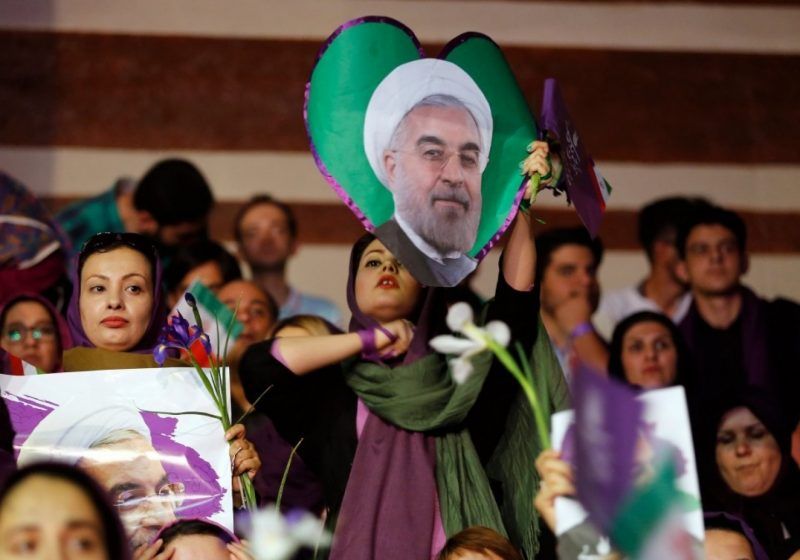
In elections on Friday, Iranian President Hassan Rouhani won a second term and reform candidates gained seats in municipal councils across the country. A right-wing conservative in the 1980s, Rouhani ran as a moderate in 2013, and today reformists are celebrating his landslide victory. How does this shift illuminate Iran’s changing politics?
How electoral limitations constrain reformist voters
Pro-democracy voters in Iran have become increasingly pragmatic in recent years. To compete in elections, candidates must first be approved by the Guardian Council. In 2013, the reformists’ main presidential candidate, Hashemi Rafsanjani, was disqualified, and reformists decided to back Rouhani as an alternate. And again in the 2016 parliamentary elections, pro-reform voters supported a reformist list, despite the Guardian Council disqualifying even their second- and third-tier candidates.
How reformist voters influence candidates
However, the influence of pro-reform Iranians extends beyond choosing among permitted candidates. The discourse and actions of Rouhani and some reformist members of the parliament show how the electorate has pushed officials to adopt a more pro-reform orientation in their political maneuvering.
Rouhani belonged to the right-wing of Iranian politics in the 1980s, which became the conservatives of the 1990s onward. When Rouhani initially ran in 2013, he identified as neither reformist nor “principalist” — how conservatives in Iran refer to themselves — but rather as moderate. His campaign focused on solving the nuclear issue and rescuing the Iranian economy from the burden of sanctions. He also promised to open the repressive political environment, particularly after the crackdown on opposition and dissidents since 2009.
And although Rouhani’s reformist discourse was relatively limited during the 2013 campaign, activists read between the lines and saw his presidency as an opportunity to escape the closed political arena shaped by Mahmoud Ahmadinejad.
By contrast, in his 2017 campaign, Rouhani vocally criticized hard-liners for their authoritarian methods. He lambasted his hard-liner rivals for their repression of opposition, criticized the judiciary for violating the constitution and demanded the Revolutionary Guard stay out of politics. Not even Mohammad Khatami, Iran’s reformist president from 1997 to 2005, had dared to take such strong public positions. Many believed Rouhani has crossed red lines.
How voters moved Rouhani to the left
This move toward more radical reformist positions occurred in the context of the hard-liners’ attacks on Rouhani’s economic performance and perhaps his realization that he lacked the 50 percent of the vote required to win the election in the first round. By going on the offense and adopting reformist positions, Rouhani attempted to sway undecided, politically dissatisfied voters.
In Rouhani’s campaign speeches across the country, audiences often chanted pro-reform slogans and demanded the release of political prisoners — specifically, Mir Hossein Mousavi, Zahra Rahnavard and Mehdi Karroubi, opposition leaders under house custody since 2011. The passionate, pro-democracy mood of these gatherings was similar to those in 2013, when reformists first aligned with Rouhani. These campaign events served to not only energize the base but also spread excitement throughout the electorate.
The pro-reform transformation of Rouhani’s discourse during the election could also signal how participating in these campaign meetings transforms the discourse of the candidates running for the office. Throughout their term, Iranian presidents usually attend public speeches and visit provinces, drawing large crowds. However, these gatherings are usually less political and emotional as the crowd is mostly there to greet the president and listen to his speech.
In election campaigns, however, the exchange between the candidate and the crowd is more interactive, with participants expressing their demands through slogans, pictures and symbols. With the institutionalization of semi-competitive elections in Iran, now election campaign gatherings are also becoming some of the few political public gatherings that happen in Iran at least every four years.
The importance of the online sphere
While campaigns provide a seasonal outlet for pro-reform electorates to push their agendas, the online space has proven a more constant arena for Iranian citizens to express and spread their demands. About 70 percent of Iran’s 80 million citizens are Internet users, who use online platforms such as Twitter, Instagram and Telegram, to discuss political and social issues. While the Iranian press is strictly limited and closely monitored, discussions over social media take place relatively free from those limits.
Even though the judiciary has occasionally cracked down on reformist administrators of some online channels, such repressive measures have not stopped circulation of critical materials against the government. And discussions go both ways. Not only do these channels allow citizens to discuss their main issues of concern, but they also enable the political elite to learn what resonates with voters.
The online and offline participation of citizens has changed the discursive field in Iranian politics, regardless of the presence of reformists in power. Even when reformists were kicked out of power and banned from electoral races, their positions were nonetheless articulated and well-defined. In such contexts, when moderates or independents, such as Rouhani, are cornered by hard-liners and need votes to stay in office, they understand that an option for them is to move toward the left and identify with the reformist positions that at the moment do not have their initial articulators in the power bloc.
Lessons for elections in authoritarian regimes
Scholars of electoral authoritarianism debate what the function of elections are in such regimes. Some claim elections are a means for the government to co-opt the elite and divide the opposition. Others contend that elections provide a mechanism for managing elite conflict and distributing spoils.
Elections in Iran are far from fair and free and may indeed serve some of these functions for the regime. However, buoyed by online and offline participation, pro-democracy Iranians have used elections to sabotage hard-liners’ electoral chances, boost the prospects of moderate candidates and push centrists toward more reformist positions.
Mohammad Ali Kadivar is a postdoctoral fellow at Brown University’s Watson Institute for International and Public Affairs.
